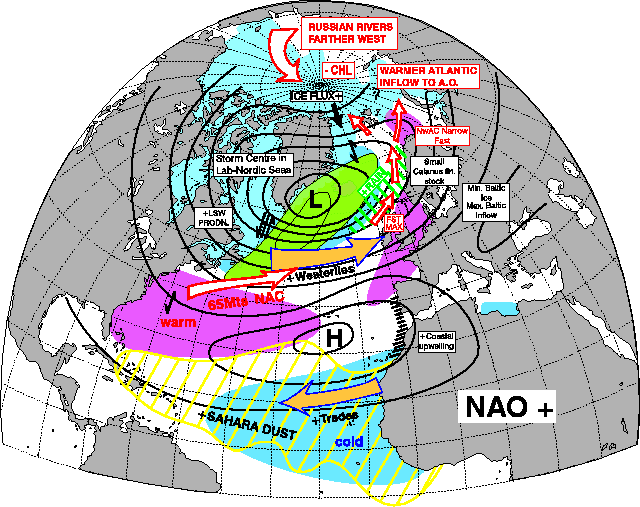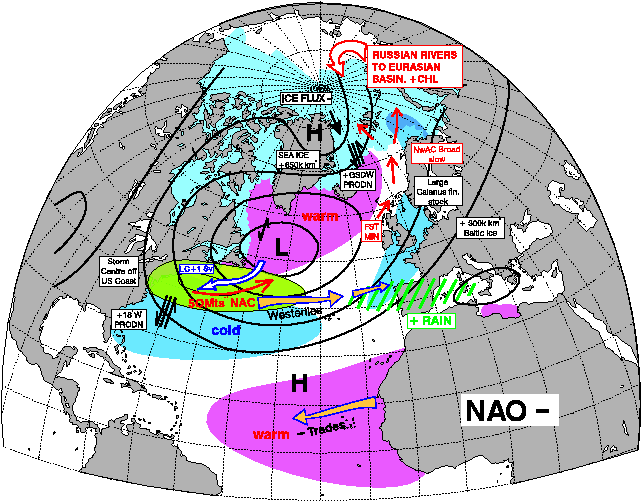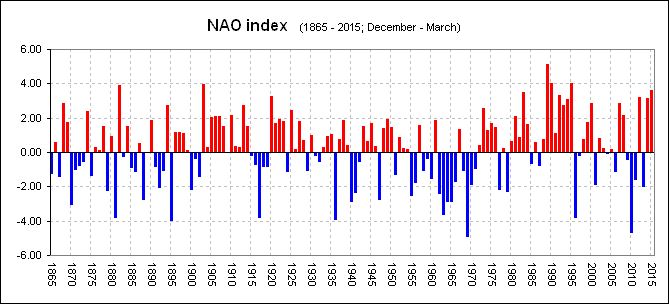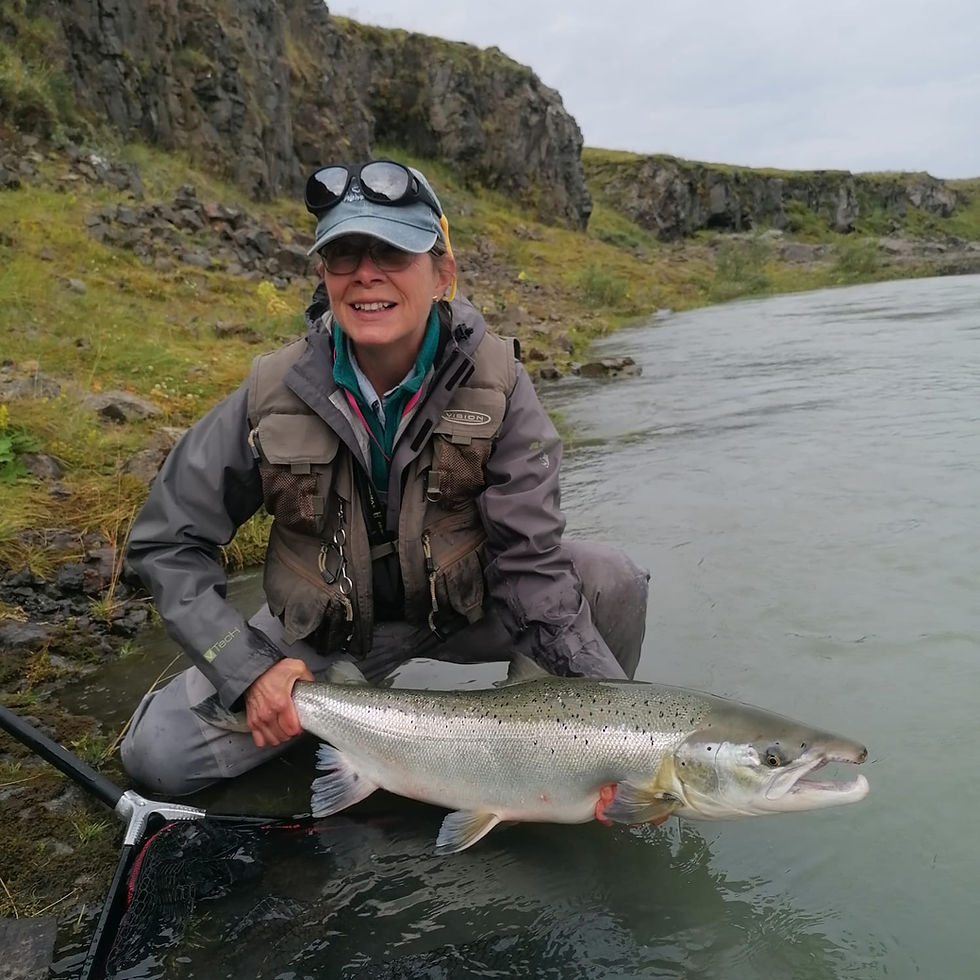The North Atlantic Oscillation and its Influence on “Abundance” of Atlantic Salmon
- Ian Gordon

- Feb 17, 2020
- 7 min read
Having both a marine and freshwater phase in their lifecycle make the Atlantic Salmon highly adaptable but also vulnerable, particularly to the lack of food at any given phase in that cycle, both in fresh and during the salt water cycle.
Do we have Different Salmon in the Spey?
As far as our fishery on the Spey are concerned, Multi Sea Winter [MSW] Spring Salmon, are the most valuable and important as those provide us with a long fishing season, attracting anglers from February through to October.
Most of those fish are 4 years old when they return to the river to spawn, having spent 2 year in the river as Juveniles, and two in the sea as adults. The leave the river in May/June, entering the sea as fish between 3 and 6 inches long. Once there they weight quickly, on average, given reasonable supply of food, as much as 2kgs in the first and further 4kgs in the second year at sea.
Grilse on the other hand are salmon that have spent only one winter at sea. They too tend to be 2year-old when they leave the river as juveniles and will put on a similar weight during their first and only winter at sea, before returning as small salmon in June, before tailing off in August. As they all leave at much the same time [May/June]and at a similar size, the reason why some return as Grilse [one sea winter salmon] and others as [MSW] salmon is not fully understood. It has nothing to do with sexual maturity as Juvenile salmon are already sexually mature before leaving the river but will almost certainly, if thinking about it rationally, involve food.

Apart from the one year at sea which influences the size of the salmon, is there any other difference? Yes, is the answer to this. Long term tagging projects from as long as 100 years ago, show that MSW salmon migrate much further into the Atlantic than Grilse. This is the most obvious link to the abundance of food in a particular part of the ocean being a key factor in the success of one or the other. Interestingly its seldom we have good years for both. In my time on the river [40 years] I’ve seen less than a handful. Those however, were the “bumper” years.
Whilst Grilse spend their one and only year feeding between their river of origin and no further than the Norwegian Sea, MSW fish do most of theirs in North Norwegian Sea, Denmark and even Davis Straits. Those are true Nomads of the sea. At times this instinct to migrate further makes them vulnerable. At other times it will lead to abundance.
Man plays a big part in abundance too. What we will see below are “natural” fluctuations. However, man, and his plundering of the ocean, industrial fishing for krill, sand eels, shrimp etc, and the knock-on effect for species feeding on juvenile salmon, undoubtedly, will have a negative effect on overall abundance.


The North Atlantic Oscillation (NAO) index [below],is based on the pressure difference between the Subtropical (Azores) High and the Subpolar Icelandic Low.

See Here for a very good, easy to understand 2 Minute You tube Explanation - https://youtu.be/KOYJG7j4Iy8
The term "North Atlantic Oscillation", was first coined by the British Climatologist, Sir Gilbert Walker in the 1920s, when he described it as a see sawing effect of relative changes in pressure between two regions, the Azores and Iceland. As we can see above, it’s normal to have 3 - 6-year periods of one or the other, a fluctuating, oscillation between positive and negative. However, when we have longer periods of one or the other, this is when we see “extremes” in weather, resulting in longer term shifts in ocean currents, which, In terms of Salmon abundance, lead to good or poor feeding.
The long period of Negative NAO 1950s – 70s is not normal. As was the period of High NAO in the 1990s. Both led to extremes in salmon abundance.
It doesn’t take a rocket scientist to work out that, in the natural world, "abundance" [in this case, Atlantic Salmon] is a by-product of -
1. Successful Spawning, 2. Good Feeding. 3. Protection from Predators - Seals, Fishing eating birds and Man!
Take any one or two away and "Abundance" simply won’t occur! Take all three away and the species will go into decline. Properly managing this species is about properly understanding and managing the 3 points above. In this blog I’m focusing on feeding in the ocean, and the obvious effects of The North Atlantic Oscillation [NAO], on feeding in particular parts of the ocean and how in turn how, potentially, they will influence the abundance of Grilse or MSW salmon.
In depth reading about the effect on plankton can be found here - https://1drv.ms/w/s!Am-p2vhkHnr-g4VhShPXXWuWp5DsPw?e=UMwHEw
The two graphs above show the two different Phases of the NAO [the little brother of the Pacific’s El Nino] and illustrate clearly what happens in different parts of the ocean during a very "normal" shift in the Jetstream.
In a nutshell, during a positive phase of NAO the area of ocean to the west of Greenland where lots of our MSW Salmon feed, Sea Surface Temperature [SST] is colder, resulting in a delay in the spring bloom of plankton, thus offering poorer feeding conditions during migration, so poorer marine survival of during this phase. However, during the same phase, both The North Sea and Norwegian are Sea are Warmer, obviously producing the exact opposite, so better marine output in this area [all very natural]! This Positive Mode leads to better survival rates of migratory fish dependant on feeding closer to home [Grilse].
As far as our fishery on the Spey is concerned, MSW Spring Salmon, are the most important as those provide us with a long fishing season, attracting anglers from February through to October. Those fish are 4 years old and have spent 2 year in the river as Juveniles and two in the sea as adults. Grilse on the other hand, tend to arrive in the River in June, tailing off in August. MSW fish tend to range from between 8 and 18lbs in weight where Grilse generally come in between 3 and 7lbs
During this positive phase of the NAO, Grilse, Small, 3year-old salmon, (fish that has spent the same two years as juveniles in the river, but only one winter at sea), became the main fish component.
Apart from the one year at sea which influences the size of the salmon, is there any other difference?
Yes, is the answer to this. Tagging projects show that [MSW] salmon migrate much further into the Atlantic than Grilse.
With the exception of the first stage of their migration, MSW salmon spend an extra year feeding in different area of the ocean. Generally speaking, Grilse do all their feeding in the Norwegian Sea whilst MSW fish do most of theirs in the Denmark Straits and beyond. .
During the NAO “Negative” Phase, the western Atlantic warms. The same area of ocean cools during the Positive phase. All of this has a massive effect on the availability of food for all fish in those areas. In the case of migratory salmon, this will be the biggest single factor to whether we have “abundance” or not. The Weather.
With the exception of a few [decent salmon years], The Years between 1980 and 2010 have predominantly been NAO Positive, so less suited to fish with long migrations.
Summery
During the period 1950 - 70's, the cycle was predominantly negative, something which in the long term is, "not normal". During this time [Often referred to as the good old days], MSW Spring fish were the main stock component in most of our rivers. On the other hand, due to their part of the ocean being colder so producing less food, grilse were not much worthy of a mention and those returning to our rivers were small 2 - 3lb ‘Mackerel Like fish’, very different to the Grilse of the 1980s and 90s, when, due to better feeding, fish were more abundant and much bigger.
It has to be pointed out that the period 1950s - 70s comes after 5 year of conflict when man had less impact on salmon both in fresh and salt water.
The NAO affects - Ocean currents – Which influence - Availability of Food - Which determines the abundance of fish in that particular part of ocean at that particular time. Although the "reasons" for this are complex and global, linked to the Southern Oscillation or “El Nino”, the "results" are very simple to understand and it doesn't take a rocket scientist to work it out. The information has been available for some time so nothing's new!
Is it climate change? Yes, because the climate has always changed, one phase will produce weather, feeding and survival that's very different to that of the other. Is it normal? No, in the relatively short time [since 1865] this has been monitored, long periods of either one or the other is not normal. Will it Change to another extreme again in the future? Yes, of course it will 100%. Will the salmon make a recovery? Of course, they will. The main driver to this happening will not be what takes place “naturally” at sea. Future abundance will be up to man and how he manages what nature provides.
If we carry on -
1. Killing Sand Eels, Krill, Sprats, Anchovies and pout [small fish] as my Granda called them. This will result in less salmon. No Doubt.
2. Damming Rivers will result in less salmon. No Doubt
3. Allowing fish Eating Birds to colonise and breed unhindered, with, other than man, no natural predator. This will result in less salmon. No Doubt
4. Spaying too much nitrogen and chemicals on the land will result in less salmon. No Doubt
5. Intensive Salmon Farming will result in less salmon. No Doubt
6. Doing Nothing about an increasing Seal Population - Will result in less salmon. No Doubt
Guessing [Not even in an educated way] the number of salmon we actually have will end in more poor decision making. Counters or a system of counting are required. So what do you think should be our first move?









Need to share
We, the fishers, river owners, ghillies and all related parties must speak out now and influence the Government policy makers who appear not to understand the problems or just don’t want to understand. Given the right support items 1-6 can and must be tackled right now. The changing temperatures are another issue which is more difficult to address and needs a global solution. Many thanks, Ian, for your blogs and valuable efforts on our behalves.